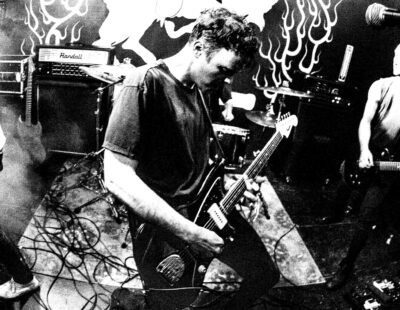
Our special report on online bootlegging first appeared in the June 2018 issue. The entire feature is reprinted below.
Dark Descent owner Matt Calvert has heard his bands described with every synonym for brutal in the thesaurus. But he’s never heard any of them described like this: “Your unique design will brighten your bathroom and create a comfortable bathing environment.”
The item: A Blood Incantation shower curtain for sale on eBay. The same Indonesian merchant also listed shower curtains featuring stalwarts like Iron Maiden and nu-metal bands like Korn. Calvert had seen bootlegged patches and T-shirts but never thought someone would try to sell death metal bathroom merchandise.

Again, it was time to contact a bootlegger and tell them they were selling copyrighted material. “Most of the time they may make excuses that the band’s not active,” Calvert says. “The last two have offered to make it official merch since a deal was made to give the band copies. But honestly, who would trust someone that just got caught bootlegging to be on the up and up?
Bootlegging—both of recordings and of band merchandise—has been part of metal music and the underground since before the tape-trading days. However, there has been a considerable shift in bootlegging culture in the past five years. In the past, bootleg albums, shirts and patches were usually labors of love designed by hardcore fans already inclined to purchase any available piece of band merchandise. In 2018, it’s more likely cash-grab items produced in Eastern Europe, Russia or Indonesia. The cheap items have included neon Celtic Frost bar signs, carseat covers featuring the Death logo, and licensed artwork, panties, coffee mugs, and countless thousands of unlicensed and poorly designed T-shirts.
The nature of bootlegged merchandise makes calculating a financial toll almost impossible. But bands, label executives, band managers and attorneys say the end result is less money for artists navigating a cash-strapped music business. With records generating minimal revenue, merchandise is one of the remaining lifelines. Small bands count on merchandise sales to make touring profitable, and often any money a band makes online isn’t from records. Typically, a full-color band shirt takes roughly $8 to produce, and proceeds are split between band and label; bootleggers pocket almost all of their earnings outside of minimal production costs.
This is how online bootlegging works. Ads that feature mockups of band shirts or tchotchkes, often with classic album covers, are posted on social media sites like Facebook. The items are made to order, then sent in a small package that easily evades detection. Online bootleggers know that internet anonymity and the difficulty of enforcing trademark laws work in their favor. Many bootleggers carry no stock and only produce items on-demand. By the time they receive a cease-and-desist letter, they’ve cashed in and disappeared.
“Sometimes it’s hard to find where the line should be,” says Karim Peter, who handles metal merchandising at IndieMerch. “When I come across something and it’s clearly a kid that made 20 patches for his friends and is selling the extra five on Instagram, I’m not going to even think about busting his balls. When it’s someone doing that with 50 different bands and a fully stocked Big Cartel store, it’s a different story.”
For many bands, tracking bootleg merchandise is like a game of whack-a-mole. Blake Harrison says the same bootlegger has offered Pig Destroyer merchandise under different business names. When the fraud is reported to Facebook, the bootlegger changes its name and continues to sell the same shirts. “Making your own patch or shirt is cool. You’re not trying to make money off of someone else’s property,” Harrison says. “We’ve seen tons of people make their own shirts, or paint a design on their jackets, but those people aren’t trying to sell an idea that’s not theirs.”
“It’s a fool’s mission. We have a big catalog and I’d need to have a full-time employee to deal with this,” adds Rennie Jaffe, vice president and label manager for Relapse Records.
The end result is the crass commercialization of a scene where authenticity is a virtue. It’s now difficult to discern which bootleggers are earnest fans and which are con artists. “If it was up to me, I would treat bootleggers the same way I would treat someone that broke into the band’s dressing room and stole money directly from them… because that is exactly what they are doing,” says Ace Trump, CEO of Siren Artist Management, who works with Saxon, Uriah Heep and others. “The band’s image and name are products (or brands). And bootleggers are stealing them outright.”

FROM ARENAS TO E-COMMERCE
Long before the internet, bootlegging was a problem. Trump toured with Judas Priest and other rock acts years ago and recalls stalls filled with shirts, high-end jackets and jewelry. He also remembers a notorious bootlegger in Los Angeles who would print shirts in water-soluble ink. If he didn’t sell shirts, the bootlegger would repaint them with a different design and return the next night.
Still, bootlegged merchandise was largely limited to live events and bigger bands. In the underground, bootlegged CDs popped up as hardcore fans sought out unreleased music or retired artwork. In the early days of e-commerce, eBay listings were crowded with items like the “Created to Kill” bootleg of Chris Barnes singing material from what eventually became Cannibal Corpse’s Vile, a live CD of Rob Halford singing with Black Sabbath in Southern California (“Ozzy Meets the Priest”) and multiple live bootlegs of Ian Gillan fronting Sabbath’s Born Again tour. “It used to just be the bigger bands and the more obscure and underground bands,” Jaffe says. “But now it’s across the board. It used to be you had to be committed and have something like a screen printer to make bootleg shirts. But now you can make any shirt you want on demand.”
In the late ’90s and early ’00s, there was a brief free-for-all with bootlegged music thanks to Napster, where you could find almost any song as an MP3 and transfer it to a CD. With the move to paid music services and, later, the ability to stream almost anything for free on YouTube, bootlegging of music became less of an issue. Bootleggers began to focus largely on merchandise.
The advent of e-commerce made bootlegging more insidious and tougher to track. Peter, who previously worked as the Black Dahlia Murder’s tour manager, said he receives screenshots of people selling merchandise via Facebook ads. The ads usually take buyers to sites where you can upload any design and print a shirt. Another scam: A seller will post an ad on Amazon made to look like official merchandise.
“Most of it is boots of classic album tees or trying to copy current designs so they can just slide in the mix with official wholesale buyers reselling on third-party sites like Amazon or eBay,” Peter explains.
Not all of the bootleggers are abroad, either. “In the past, most of the boots being sold online for our bands were coming from Indonesia, but now, with the third-party printers, you’ll end up getting stuff from all over,” Peter says. “We got one from Arizona the other day. Kids don’t even know they ordered a boot off Amazon until it shows up and looks like someone pasted a CD booklet to a tee.”
While larger bands get a bigger financial hit, smaller bands are also affected because even losses of a few hundred dollars are significant. Many bands even find that they can’t sell new shirts because people are interested in old designs and the bands don’t own the rights. “The band can barely sell 50 of a new tee because fans are just buying the boot of the cover they want instead,” Peter says. “People tell them they should just print the shirt themselves, but sometimes getting those rights back officially costs more than the band or bootlegger is making.”
There are also thorny questions of copyright and intellectual property law. Rebecca Tushnet, the Frank Stanton professor of first amendment law at Harvard, said three considerations apply to bootlegs: copyrights apply to specific album and T-shirt designs; trademarks apply to band names; “the right of publicity” gives someone the right to control commercial use of their likeness. “The legality is in general not that debatable,” she says. “The issue is really one of detection and enforcement. A small shipment is rarely going to get inspected, and that’s a hard thing to individualize. So, it comes down to the platforms to police it.”
If altered or reworked, some bootlegs might qualify for fair-use protection, which allows limited use of copyrighted material without permission. “It is a very case-by-case thing, and it’s hard to say in the abstract,” Tushnet explains. “The courts have not been favorable to people who have just exploited the commercial value. If you are making something hand-painted, that doesn’t really affect the market for memorabilia like a mass-created mug with a standard picture would.”

FANS VS. THIEVES
A complicating factor is metal’s history of tolerated bootlegging. Even the largest labels draw a line between the cut-and-run merchants on online sites and fans trying to pay tribute to their favorite bands with homemade items.
Jarvis Leatherby, who manages bands including Cirith Ungol and Satan for Iron Grip Management, said trying to crack down on bootlegging in parts of the world like Mexico and South America could alienate fans and lead to the perception that the bands only care about the money. Bootlegging is a critical part of the culture there because of rabid devotion and economic necessity.
“For every bad shitty thing like a shower curtain, I have seen some cool and original stuff like artwork, or a T-shirt you haven’t seen before,” Leatherby says. “And people like that stuff. If I find that stuff, I hit them up. If I sent them patent information, they would run scared.” Instead, he tries diplomacy. “Eight times out of 10, it is a fan of the band or of the genre. It’s not making them rich.”
“There are definitely people who are fans and just don’t know how to get in touch with a band that made a record five years ago and want to make a cool shirt,” Jaffe adds. “By the letter of the law, that’s no different. But that’s far less ugly to me than someone who is flat out stealing.”
Triptykon frontman and Celtic Frost co-founder Tom Gabriel Fischer said there are still many fans in small towns and isolated areas who make items because they love the bands and can’t get their hands on legitimate merchandise. “It is a different universe if fans construct their own tokens of dedication—as I did as a teenager—versus some individual detached from the scene simply looking to make a substantial profit from both fans and bands that he or she doesn’t care about.”
Fischer adds that large merchandising companies are hardly blameless. He said in the early ’00s Celtic Frost was approached by a merchandise company seeking to use H.R. Giger images without approval. “This company wanted to enter into a merchandise deal with us, and they sent us unsolicited design proposals, using a variety of paintings by Giger that have no connection whatsoever to Celtic Frost,” Fischer says. “When we responded indignantly, they wrote to us along the lines of ‘Chill, Giger will never find out, and these will sell like crazy.’” That company never became a partner.
Wake guitarist Rob LaChance grew up making his own hardcore shirts with paint and stencils in a small Canadian town. “I don’t see any issue with a 15-year-old making his own Birdflesh shirt,” he says. “I have an issue with a 35-year-old selling for profit and directly ripping off bands that could actually use that money to tour and record.” His band hasn’t been exempt: A bootlegger in Indonesia put the Sowing the Seeds of a Worthless Tomorrow album cover on a shirt.
BEATING THE BOOTLEGGERS
There is almost universal consensus that bootlegging is here to stay and will only multiply. While getting an attorney is possible if you are Gene Simmons and don’t mind alienating fans, smaller bands need to be creative. Some acts reach out and ask for bootlegged items to be removed. Others act only when the bootlegging is egregious. Harvard professor Tushnet said there are a number of firms available for hire that can track and report any bootlegged content, although that might be too costly for smaller bands and labels.
Still others try to get the bootleggers on their team. “There have been instances when either the bootlegger was a very small, pure and enthusiastic fan or the bootlegs were so original and well made that we decided to pass on any action,” Fischer says. “There were occasions when the designs were so inspirational that we ‘bootlegged the bootlegger’ and began to produce them ourselves.”
Leatherby said that before his acts perform at large festivals where he knows unlicensed merchandise will be sold, he tries to partner with bootleggers to split profits. Prior to a European festival, he was able to work out deals with 18 bootleggers. “We ask them for a percentage. Some people are stoked to be involved with the band.”
While online bootlegging is epidemic, Jaffe says bootlegging at festivals also remains a significant problem. Jaffe strolled around the Maryland Deathfest lot one summer and found countless items bootlegged from his label’s catalog. “It’s literally an open-air market for T-shirt bootleggers. Relapse and Season of Mist and Nuclear Blast have booths, and these stands will have catalogs of bootleg shirts. It’s frustrating because it takes money out of a band’s pockets and away from those of us who do things the right way and pay bands.”
Fans are also responsible for policing the scene. Many fans shame bootleggers in comment sections, tag friends in the bands in bootleg ads or report the sites as fraudulent. Most of all, fans need to be aware who is getting their money when they press pay. “[Fans] know where it’s coming from before they agree to purchase it,” Jaffe says. “If we as the record labels that pay to grow and develop these bands don’t have an income stream, which is shared with the bands, then literally this whole scene could dry up.”






